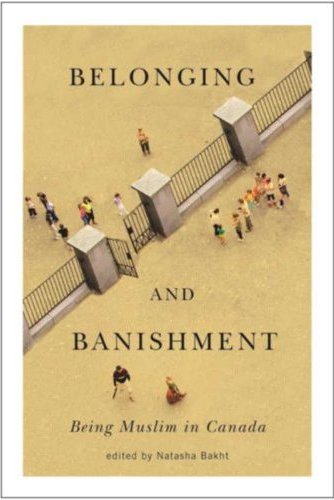The past seven years have not been kind to the Muslim identity. Post 9/11, society’s views on Muslims have changed substantially. In this new world – shaped by the horrific images of the collapsing twin towers – identifying yourself as Muslim is a hefty confession.
It’s often met by a raised eyebrow and perhaps a soft exhale. Then comes the barrage of questions and observations, subtly revealing society’s myths about Muslims. Why don’t you wear a veil? You don’t seem to be a typical Muslim woman. You were born Muslim – but you’re not practicing right?
As the surprise slowly wears off, out comes the curiosity. What’s it like to be Muslim in Canada?
It’s exactly this question that Belonging and Banishment: Being Muslim in Canada aims to tackle, against a background of issues facing Muslims in Canada today. The book, edited by University of Ottawa assistant law professor Natasha Bakht, is a finely woven collection of essays that presents multiple answers to the question of being Muslim in Canada.
The strength of the book lies in its prominent roster of Muslim authors who vary in degrees of practice and belief; from Toronto Star editor emeritus Haroon Siddiqui to Muslim Girl magazine editor-in-chief Ausma Zehanat Khan to Syed Mohamed Mehdi, philosophy professor and musician. More importantly, the collection draws on an equal number of female and male writers, who represent various cultural backgrounds and hail from across Canada. What results is a group of essays that reads more like a textbook than story, each seeking to highlight one part of the identity puzzle.
The breadth of material in the collection is impressive; exploring critical issues such as media coverage of Muslims, the continued detention of Omar Khadr and the ubiquitous discourse about Muslim women and the veil. Anyone with an academic bent will appreciate these well-argued and well-supported pieces.
But as a Muslim woman born and raised in Canada, it was the intensely personal essays that resonated most with me. From Anar Ali’s beautifully crafted essay on her difficult decision to finally name the Ismaili Muslim community in her writing to Arif Babul’s entertaining parallel between a eureka moment in a scientist’s life and Islam, some of the essays powerfully draw readers into the complex world of navigating multiple identities.
As often happens with personal essays that attempt to generalize from individual experience, there are times where I disagreed with the book. Rukhsana Khan’s essay on raising her children as Muslims in Canada had me shaking my head. As she detailed how she asked the teachers at her children’s school to keep her children from participating from any Halloween and Christmas activities, her strong position challenged my view of what it means to be a Muslim in Canada. It challenged the plurality of traditions that I was raised within; from the Christmas tree erected in my living room during childhood to listening to speeches by the Dalai Lama to attending mosque on Fridays. Khan’s and my mother’s diverging views on how to foster tolerance and acceptance in children underscores the point that Muslim parents across Canada are raising their children differently, a point that was missing from Khan’s essay.
Coming to Khan’s rescue are the other authors. Anar Ali tells of being encouraged by her father to read the Bible as a child while Ausma Zehanat Khan speaks of the challenge of crafting a magazine aimed at Muslim girls that pays tribute to their varied lifestyles and approaches to practicing faith.
One of the most interesting themes that repeatedly rears its head during the book is the role of critics from within the Islamic community, such as The Trouble with Islam author Irshad Manji. Anar Ali begs her to consider the fact that there are one billion Muslims in the world and that to speak for all of them is impossible, while Karim H. Karim finds that critics like Manji are being lauded by some Muslims for creating new spaces for critical discussions about Islam. And while author Amin Malak welcomes the criticism, he warns that media must learn to distinguish “between serious, thoughtful critique and sensational, publicity-hungry superficialities pandering to the prejudices of Western dominant discourses.”
The book was interesting, but I wanted more. I would have liked to see more discussion of how women within some sects of Islam reconcile their faith with how they are treated as women within the faith. While the degree of patriarchy varies widely across Muslim communities and can be attributed as much to culture as to religion, it cannot be overlooked. Ausma Zehanat Khan alludes to the alienation that some women feel from the mosque in detailing how Muslim girls, in a column called “GirlSpace” complain of “dark, exclusionary entrances, the reduced, uncomfortable prayer space, or the sometimes regressive and disenfranchising nature of Friday sermons.” For some Muslim women in Canada, this remains a point of contention and a barrier to their full participation in the Muslim community. More discussion on the issue would have strengthened the book.
But the main fault of the book lies in its brevity. It could have used more essays, more views from Muslims in Canada, more pluralism. But its 11 essays offer great kindling to spark this sorely-needed discussion on Muslim identity in North America. And I have a feeling that in asking for more, I’m asking for the impossible. Even if collections like this were to encompass hundreds of essays, the diversity of Canada’s Muslim community – numbering almost one million in population – dictates that it still would not capture the multiplicity of experiences of Muslims living in Canada.
AK is a freelance writer based in Ottawa.




